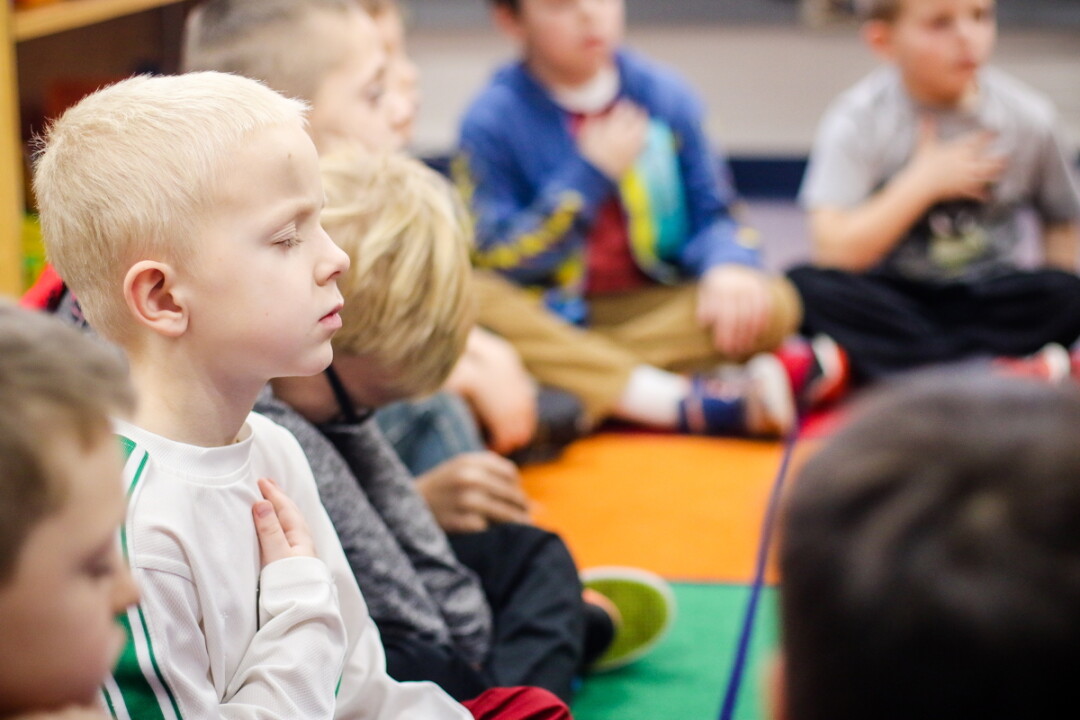Mindfulness in the Classroom
students, teachers say meditative practice improves kids’ lives
Kristin Schrader, photos by Andrea Paulseth

Mindfulness, one of the many forms of meditation, is gaining recognition in educational systems throughout the world. In the Chippewa Valley, there are many teachers either applying formal mindfulness skills or skills such as deep breathing to help students be more aware of their own bodies, emotions, and environments. Mindfulness in the school setting is showing positive results in the areas of improved attention, emotional regulation, increased compassion, resiliency, adaptability, and improved calming capabilities for students, according to Mindful Schools, an organization that teaches mindfulness to educators. Happiness and having a sense of well-being are skills – just like learning core academics – that many kids are not taught or modeled.
“Mindfulness does not always mean being still or quiet, but being aware of where our attention is, regardless of what we are doing.” – Abby Seveland, Lakeshore Elementary
Getting and maintaining the attention of students is a core area of struggle in many classrooms. Students are continuously told to pay attention, but who teaches them how to pay attention? According to The Center for Healthy Minds at UW-Madison, mindfulness meditation not only teaches people how to pay attention but also how to sustain attention. Abby Seveland, a teacher at Lakeshore Elementary School in Eau Claire, has been trained through the Mindful Schools Educator Essentials course and has taken a local six-week course with Ann Brand, a mindful meditation teacher and instructor at UW-Stout. Seveland describes mindfulness to her students as “paying attention, on purpose, to something happening right now.”
Seveland emphasizes to students and other teachers that “mindfulness does not always mean being still or quiet, but being aware of where our attention is, regardless of what we are doing.” She noticed her students who practice mindfulness in the classroom on a regular basis are more able to notice when focus is lost and are able to bring their attention back to the task at hand by using strategies she teaches. “Other teachers have stated that their students are asking for moments during the day to practice paying attention to their breathing together,” she said.

According to Seveland, mindfulness addresses two aspects of classroom management. “Mindfulness practice gives teachers and staff the opportunity to build their own mindful practice, which allows teachers in the classroom to use strategies to keep their emotions and nervous systems regulated when working with students,” she said. “The classroom can be such a stressful place through(out) the day, and when a teacher is stressed, that stress is transmitted to the students, contributing to the students’ struggle to regulate emotions and behaviors.”
Stress can bring out the worst in students, especially when they are unable to de-escalate their emotions on their own, Seveland said. “This can quickly and unintentionally escalate situations with student behaviors,” she explains. “Mindful educators are also able to be in the moment with students despite the tens of things on their minds trying to pull our attention in different directions. As a teacher, our presence is really the first intervention for students who are struggling with behaviors.”
With rising numbers of children experiencing toxic stress because of their home environments, social lives, or school environments, mindfulness is an inexpensive and efficient tool that may provide lifelong coping skills and decrease mental health symptoms. “In addition to all of this, when we teach students strategies to tune into the present moment and pay attention to their thoughts and bodies, we are creating a space for students to respond rather than react,” Seveland said. “When kids have the strategies to slow down and bring their awareness to how they are feeling, they are then able to make purposeful choices on how to respond to situations.”

